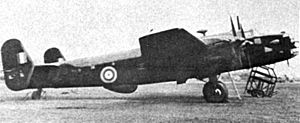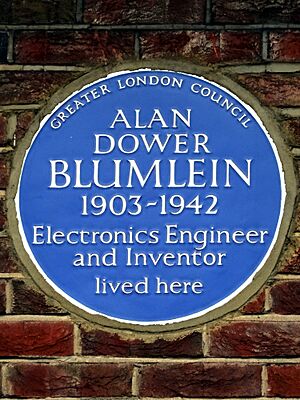Alan Blumlein facts for kids
Quick facts for kids
Alan Dower Blumlein
|
|
|---|---|
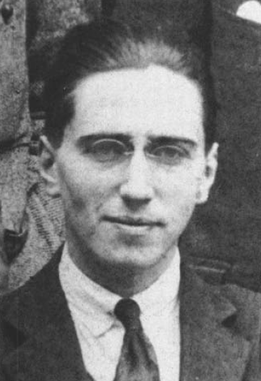
Blumlein in 1931 or 1932
|
|
| Born | 29 June 1903 Hampstead, London, England
|
| Died | 7 June 1942 (aged 38) Welsh Bicknor, Herefordshire, England
|
| Cause of death | Plane crash |
| Education | Highgate School Imperial College London |
| Occupation | Electronic engineer |
| Employer | EMI |
| Spouse(s) | Doreen Lane |
| Children | Simon Blumlein David Blumlein |
| Parent(s) | Semmy Blumlein Jessie Dower |
| Engineering career | |
| Projects | H2S radar |
| Significant design | Ultra–Linear amplifier |
| Significant advance | Stereophonic sound television |
Alan Dower Blumlein (born June 29, 1903 – died June 7, 1942) was a brilliant English electronics engineer. He invented many important things in areas like sound recording, stereophonic sound, television, and radar. He held 128 patents, which are like official papers for inventions. People thought he was one of the most important engineers and inventors of his time.
He died during World War II when he was only 38 years old. This happened on June 7, 1942, during a secret test flight. He was testing a new H2S airborne radar system when the plane he was in crashed. Everyone on board died in the crash near Welsh Bicknor in Herefordshire, England.
Contents
Early Life and Education
Alan Dower Blumlein was born in Hampstead, London, on June 29, 1903. His father, Semmy Blumlein, was from Germany but became a British citizen. Alan's mother, Jessie Dower, was from Scotland.
It seemed Alan was meant to be an engineer from a young age. When he was seven, he gave his father a bill for fixing the doorbell. It was signed "Alan Blumlein, Electrical Engineer." Even though his sister said he couldn't read well until he was 12, he joked that he already knew "a lot of quadratic equations!"
After finishing Highgate School in 1921, he went to Imperial College London. He was very smart and got a scholarship. He earned a top degree in science just two years later.
In 1930, Blumlein met Doreen Lane, a teacher. They got married in 1933. Some of his friends joked about "Blumlein-itis," meaning he only wanted to be around people with "first-class minds." But his best friend thought Alan and Doreen were a great match.
Amazing Inventions and Career
Alan Blumlein worked on many exciting projects throughout his career. His inventions changed how we experience sound and see images.
Improving Phone Calls
In 1924, Blumlein started his first job at a company called International Western Electric. This company later became Standard Telephones and Cables (STC).
While working there, he studied how human ears hear different sounds. He used this information to design special networks that made phone calls sound clearer. He also helped invent better loading coils. These coils made long-distance phone calls much clearer by reducing sound loss. He also created an improved electrical measuring device called the Blumlein Bridge.
Revolutionizing Sound Recording
In 1929, Blumlein joined the Columbia Graphophone Company. His first big task was to create a new way to cut music onto records. The old method used a special part that cost a lot in fees.
Blumlein invented a new and better way to cut records. This new method not only avoided the fees but also made the sound quality much better! He led a small team that turned this idea into a working device.
In 1931, Columbia Graphophone Company joined with another company to form EMI. Blumlein moved to their new research labs. He and his team also developed new types of microphones. These microphones were used in recording studios and by the BBC for radio broadcasts.
The Ultra-Linear Amplifier
In 1937, Blumlein patented a special kind of amplifier called the Ultra-Linear amplifier. An amplifier makes sound louder. His design was clever because it made the sound clearer and more accurate. It combined the best features of two different types of amplifier designs.
The Long-Tailed Pair
Blumlein also patented a circuit called the long-tailed pair in 1936. This circuit is a type of differential amplifier. It's still used everywhere today, especially in tiny integrated circuits like those found in operational amplifiers.
Creating Stereophonic Sound
One of Blumlein's most famous inventions is "binaural sound," which we now call stereophonic sound or "stereo." In 1931, he was at the cinema with his wife. The movies back then only had sound coming from one speaker. If an actor moved across the screen, their voice still seemed to come from the same spot. Blumlein told his wife he knew how to make the sound follow the actor!
He wrote down his ideas in September 1931. His patent, filed in December 1931, was called "Improvements in and relating to Sound-transmission, Sound-recording and Sound-reproducing Systems." It was approved in 1933.
This patent included many amazing ideas for stereo sound, some of which are still used today:
- A way to make sound seem to come from the right direction when played through speakers.
- Using two special microphones placed at right angles to each other. This setup is still called a "Blumlein Pair."
- A method for recording two separate sound channels onto a single record groove.
- A special cutting head for making stereo records.
Blumlein started experimenting with his stereo ideas in 1933. He even made short test films, like "Trains at Hayes Station," where the sound truly followed the action on screen. In 1934, he used his new technique to record Mozart's Jupiter Symphony at Abbey Road Studios in London.
Developing Television
Many people worked on television in the 1920s and 1930s. Blumlein joined the EMI team in 1933 and focused completely on TV research.
Some of his key ideas for television included:
- A way to make the electron beam in the TV tube move quickly and efficiently across the screen.
- Methods to keep the power supply stable for the TV.
- A technique called "black-level clamping" that made the picture clearer.
- The slot antenna, which is a type of antenna used for broadcasting.
Blumlein also played a big part in creating the specific way TV signals were sent for the BBC's first "high definition" television service. This system was later used in many other countries.
The Secret H2S Radar
Blumlein was so important to the development of the H2S airborne radar system that many people worried the project would fail after he died. This radar helped planes find targets for bombing. His work on this project was a big secret during the war. Because of this, his death was not announced publicly until two years later. This was to prevent enemies from knowing how important he was.
He also invented a special device called the line type pulse modulator. This was a major invention for powerful radar systems and is still used today.
Tragic Death and Investigation
Blumlein died in a plane crash on June 7, 1942. He was on a test flight for the Telecommunications Research Establishment (TRE). The plane was a Handley Page Halifax equipped with the new H2S radar system.
During the flight, the plane's engine caught fire. The fire quickly spread, and the plane lost height, then flipped over and crashed near Welsh Bicknor. Two of Blumlein's colleagues also died in the crash.
The plane was carrying a very secret device called a cavity magnetron, which was part of the radar system. It was crucial to get this device back immediately. A team arrived at the crash site that very night to recover it.
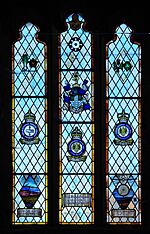
After the crash, an investigation found that the fire was caused by a loose part in the engine. This part had not been tightened properly by a mechanic. The fire spread quickly, causing part of the wing to break off. The plane then crashed.
The investigators found that the people on board could not jump out in time. This was because the plane was losing height, the fire was spreading fast, and there weren't enough parachutes for everyone. After this crash, Prime Minister Winston Churchill ordered that all test flights with scientists or civilians must have enough parachutes for everyone.
The report about the crash was kept secret by Prime Minister Churchill. The public, and even the families of those who died, were not told the real cause. This led to many rumors that German spies had caused the crash.
Personal Life
Alan Blumlein had two sons, Simon and David.
Outside of his work, Blumlein loved music. He tried to learn piano but gave it up. He also enjoyed horse riding.
He was interested in many types of engineering, including planes, cars, and trains. He even got a pilot's license and flew small planes. Once, he convinced a bus driver to let him drive the bus for a short distance! Another time, he spent hours helping a railway signal operator at Paddington Station.
Tributes and Recognition
- A road on the Tektronix campus in Oregon, USA, is named Alan Blumlein Way. This honors his important contributions to electronics.
- There is a meeting room called the Blumlein Room at the Institution of Engineering and Technology (IET) headquarters in London.
- In 1977, a blue plaque was put on his former home in Ealing, London. This plaque remembers famous people and places.
- On April 1, 2015, a special plaque was given to Alan Dower Blumlein for inventing stereo sound. A ceremony was held at Abbey Road Studios. The plaque is now at the front door of the studios.
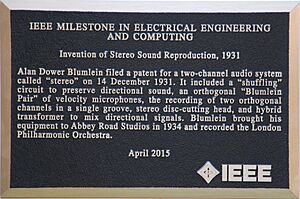
- In 2017, the Recording Academy (the group that gives out the Grammy Awards) gave Alan Dower Blumlein a Technical Grammy. This award was for his invention of stereo and his amazing technical work in recording.
See Also
- Blumlein generator
- Blumlein transmission line, used to create high-voltage pulses with short rise and fall times.
- History of television
Images for kids


